
a web page by Don Roberson |
Slate-colored Fox Sparrow: the schistacea group |
|
||||||
Slate-colored Fox Sparrows
have a plain gray head and back with contrasting rusty-red wings and
tail (particularly tail); they are small-billed (for Fox Sparrows) and
the lower mandible is yellow or yellow-orange; and their call note is a
thik (similar to that of Sooty and Red Fox Sparrows but subtlely
different so as to be recognized with practice; K.L. Garrett, pers.
com.). The plumage features can be discerned on the singing bird in
Montana (above) and on this migrant at Oakland, Alameda Co., California
(below; 4 Nov 2005 © Glen Tepke). The tone of gray on the head and
back varies a bit between populations; birds farther north, and
particular some altivagans, tend toward brown. |
||||||
 |
||||||
In California, Slate-colored Fox Sparrows winter commonly in southern coastal counties and sparingly through the deserts. They are the commonest Fox Sparrows in San Diego Co. (Unitt 2004). In Monterey County and elsewhere in coastal central California, Slate-colored Fox Sparrows occur primarily as migrants. There is not yet a known wintering bird in MTY. Indeed, Slate-colored Fox Sparrows appear to be decidedly scarce locally during spring and fall migration. There are two specimens labeled altivagans at MVZ: 20 Oct 1918 Jolon and 7 Apr 1921 Carmel (more on altivagans below). Few observers report Fox Sparrows to the 'group' level, and it seems probable that standard schistacea Fox Sparrows, like the two shown above, occur regularly in at least fall migration. In the last 15 years there have been at least 7 schistacea Fox Sparrows reported in MTY, and all of these have been between 2 Oct–24 Dec. The late bird (24 Dec 2001) was at my Pacific Grove feeder but did not stay to winter, so seems likely to have been a migrant. The others have been from well-worked vagrant spots: Big Sur R. mouth, Carmel R. mouth, Pt. Pinos, and Salinas wastewater ponds. My guess is that schistacea Fox Sparrow occurs more regularly in migration in chaparral habitats that are just not checked. |
||||||
There are difficult individual Fox Sparrows that I'm not comfortable with identifying. The biggest problem seems to be between northern Slate-colored types and westernmost Sooty types. This bird, below, was banded at the Big Sur R. mouth 16 May 2008 (photo © BSOL). It has a lot of gray in the face and back (although the back is hard to see) yet there is some mid-range brown at the nape. It is rather lightly spotted below, which tends to be a Slate-colored feature, and the uppertail coverts and tail itself appear to be contrastingly rusty-red. Given the mid-May date, it is much too late for a locally wintering bird, so I presume it is a migrant from much farther south. That fits either schistacea Slate-colored or an unalaschcensis/insularis Sooty. I'm tentatively calling it a Slate-colored, but I could be wrong. |
||||||
|
||||||
This bird (right © Tom Grey) may be an altivagans Slate-colored Fox Sparrow. The photo was taken 23 Nov 2006 in Santa Clara Co., so could be of a migrant. It basically looks like a Sooty Fox Sparrow but with a contrasting red tail (and also contrastingly rusty wings, but less obviously). That is pretty much what the painting by Beadle in Rising (1996) looks like. I had a bird very similar to this in my Pacific Grove yard on 14 Mar 2010, and it, too, was a migrant (and a one-day wonder at that). If this is not altivagans, it could be an intergrade between altivagans and a Sooty Fox Sparrow race. See the bottom of the Red Fox Sparrow page for an example of a likely intergrade between zaboria Red Fox Sparrow and altivagans (but more on the zaboria side). Here is yet another problematic Fox Sparrow (below; 25 Apr 2008 Tilden Park, Contra Costa Co., © Glen Tepke). The date is too late for a locally wintering bird, so we would assume it is a migrant from somewhere in the south. It has much gray in the supercilium and neck and (seemingly) the back, but the crown is brown. The wings and tail are a rusty-brown but not very bright yet they do look brighter than the back. The bill is fairly heavily and the underpart spotting not as extensive as some dark birds. This may be altivagans, or an altivagans intergrade with a Sooty race. Or I could be entirely wrong, and it might be from the intergrade zone between Slate-colored and Thick-billed (but towards Slate-colored as the lower mandible is yellow). There still are many mysteries to be sorted out in these groups. |
||||||
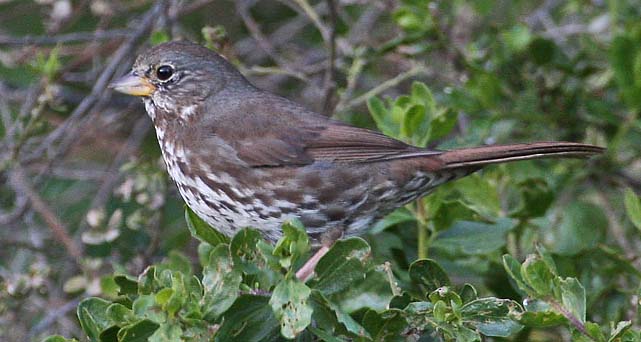 |
||||||
|
||||||
Photos: All photos © Don Roberson, except as otherwise indicated; all rights reserved. Literature cited:
|
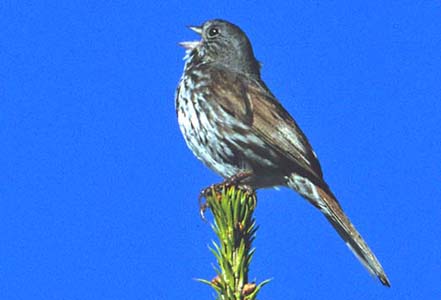
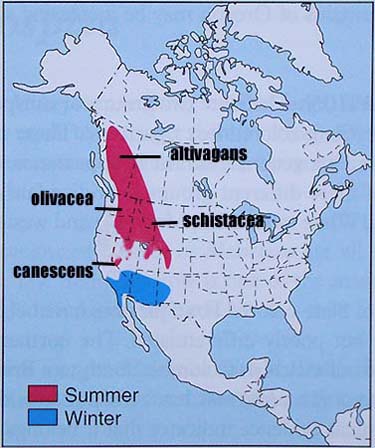

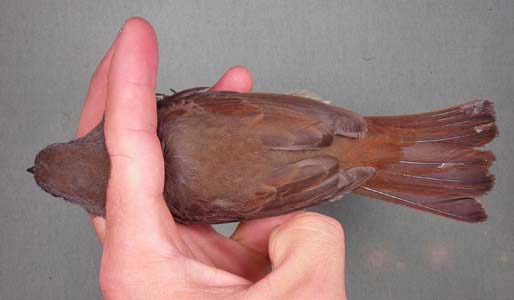
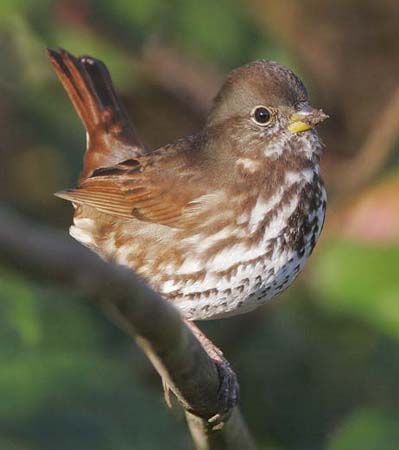 The other big problem is the subspecies altivagans. P. [i] schistacea altivagans
breeds through the interior of British Columbia (except the southeast
corner) and seems to be a very variable subspecies. It intergrades with
zaboria (in the Red Fox Sparrow group) and fuliginosa
(in the Sooty Fox Sparrow group). Few photos seem to exist, and
paintings in the literature range from good to awful: K.L. Garrett has
praised David Beadle's painting of altivagans in Rising (1996) as perhaps the most accurate.
The other big problem is the subspecies altivagans. P. [i] schistacea altivagans
breeds through the interior of British Columbia (except the southeast
corner) and seems to be a very variable subspecies. It intergrades with
zaboria (in the Red Fox Sparrow group) and fuliginosa
(in the Sooty Fox Sparrow group). Few photos seem to exist, and
paintings in the literature range from good to awful: K.L. Garrett has
praised David Beadle's painting of altivagans in Rising (1996) as perhaps the most accurate.